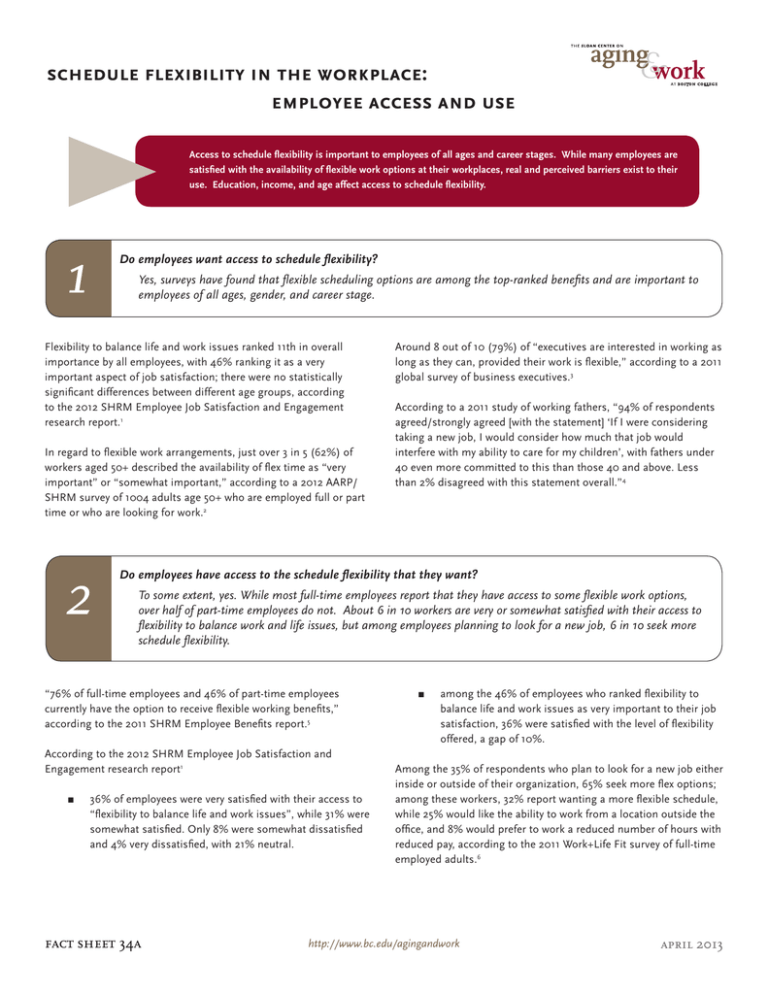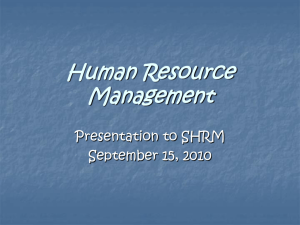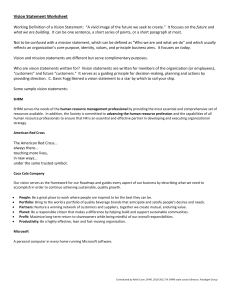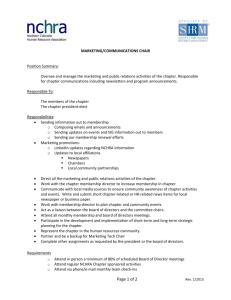schedule flexibility in the workplace: employee access and use
advertisement

schedule flexibility in the workplace: employee access and use Access to schedule flexibility is important to employees of all ages and career stages. While many employees are satisfied with the availability of flexible work options at their workplaces, real and perceived barriers exist to their use. Education, income, and age affect access to schedule flexibility. 1 Do employees want access to schedule flexibility? Yes, surveys have found that flexible scheduling options are among the top-ranked benefits and are important to employees of all ages, gender, and career stage. Flexibility to balance life and work issues ranked 11th in overall importance by all employees, with 46% ranking it as a very important aspect of job satisfaction; there were no statistically significant differences between different age groups, according to the 2012 SHRM Employee Job Satisfaction and Engagement research report.1 In regard to flexible work arrangements, just over 3 in 5 (62%) of workers aged 50+ described the availability of flex time as “very important” or “somewhat important,” according to a 2012 AARP/ SHRM survey of 1004 adults age 50+ who are employed full or part time or who are looking for work.2 2 According to a 2011 study of working fathers, “94% of respondents agreed/strongly agreed [with the statement] ‘If I were considering taking a new job, I would consider how much that job would interfere with my ability to care for my children’, with fathers under 40 even more committed to this than those 40 and above. Less than 2% disagreed with this statement overall.”4 Do employees have access to the schedule flexibility that they want? To some extent, yes. While most full-time employees report that they have access to some flexible work options, over half of part-time employees do not. About 6 in 10 workers are very or somewhat satisfied with their access to flexibility to balance work and life issues, but among employees planning to look for a new job, 6 in 10 seek more schedule flexibility. “76% of full-time employees and 46% of part-time employees currently have the option to receive flexible working benefits,” according to the 2011 SHRM Employee Benefits report.5 According to the 2012 SHRM Employee Job Satisfaction and Engagement research report1 ππ Around 8 out of 10 (79%) of “executives are interested in working as long as they can, provided their work is flexible,” according to a 2011 global survey of business executives.3 36% of employees were very satisfied with their access to “flexibility to balance life and work issues”, while 31% were somewhat satisfied. Only 8% were somewhat dissatisfied and 4% very dissatisfied, with 21% neutral. fact1 sheet 34a ππ among the 46% of employees who ranked flexibility to balance life and work issues as very important to their job satisfaction, 36% were satisfied with the level of flexibility offered, a gap of 10%. Among the 35% of respondents who plan to look for a new job either inside or outside of their organization, 65% seek more flex options; among these workers, 32% report wanting a more flexible schedule, while 25% would like the ability to work from a location outside the office, and 8% would prefer to work a reduced number of hours with reduced pay, according to the 2011 Work+Life Fit survey of full-time employed adults.6 http://www.bc.edu/agingandwork april 2013 3 Do employees use the schedule flexibility options that are available to them? Yes, but some encounter real or perceived barriers. According to the 2011 Work+Life Fit survey of full-time employed adults,6 ππ 8 out of 10 full-time employees currently use some type of day-to-day or formal work-life flexibility. Among the specific types of work life flexibility, 62% report using “some type of day-to-day, ad-hoc flex,” while 55% use “day-to-day flex hours”, 46% use “formal flextime,” and 27% use a “compressed work schedule.” ππ According to a 2011 study of working fathers,4 ππ “more than three quarters of fathers reported using flextime on either a formal or informal basis, 57% worked from home at least some part of their time, and 27% utilized compressed workweeks.” ππ “the percentages of those assuming the use of flexible work arrangements would not be supported [by their managers] were quite high: 52% of those not using flextime, 79% of those not telecommuting, and 71% of those not using compressed work weeks.” 6 out of 10 respondents reported that there were obstacles to using or improving their work life flexibility. 4 What factors influence employees’ access to schedule flexibility? Employees with lower wages and educational attainment are less likely to have access to schedule flexibility, as are hourly workers compared to salaried workers. Age is also a factor; older and younger workers have less access than those in the mid-range of the age spectrum. “Among wage and salary workers age 25 and over, 61% of those with a bachelor’s degree or higher were able to adjust their work schedules or location instead of taking time off from work, compared with only 38% of workers with less than a high school diploma,” according to a 2012 analysis of data from the American Time Use Survey.7 ππ According to a 2012 analysis of BLS data8 ππ 2 3 Brown, S. K. (2012). What are older workers seeking? an AARP/SHRM survey of 50+ workers. Washington, DC: AARP. Retrieved from http://www.aarp.org/content/dam/ aarp/research/surveys_statistics/econ/2012/What-Are-Older-Workers-Seeking-AnAARP-SHRM-Survey-of-50-Plus-Workers-AARP.pdf Economist Intelligence Unit. (2011). A silver opportunity? Rising longevity and its implications for business. Geneva: Economist Intelligence Unit Limited. Retrieved from http://viewswire.eiu.com/report_dl.asp?mode=fi&fi=1877919572.PDF 4 Harrington, B., Van Deusen, F. R., & Humberd, B. K. (2011). The new dad: Caring, committed and conflicted. Chestnut Hill, MA: Boston College Center for Work & Family. Retrieved from http://www.bc.edu/content/dam/files/centers/cwf/pdf/FH-StudyWeb-2.pdf 2 Among organizations offering workplace flexibility programs, the extent to which they are offered to exempt/salaried employees ranges from 76%-97%. Most options are also available to nonexempt/hourly employees, but to a lesser extent, ranging from 56%-93%, according to a 2011 report on a survey of managers from over 500 different business organizations.9 “workers in the bottom 40% of earners are more than twice as likely as workers in the top 40% of earners to lack access to any form of paid leave or flexibility.” References 1 SHRM. (2012). 2012 employee job satisfaction and engagement: How employees are dealing with uncertainty. Alexandria, VA: Society for Human Resource Management (SHRM). Retrieved from http://www.shrm.org/LegalIssues/StateandLocalResources/StateandLocalStatutesandRegulations/Documents/12-0537%202012_JobSatisfaction_FNL_online.pdf “workers between the ages of 25 and 54 are all equally as likely to have access to both paid leave and flexible scheduling at work--these groups each make up between 25% and 27% of the total. Among older workers, 14% of those ages 55-64 and 3% of those ages 65 and older have access to both paid leave and workplace flexibility.” 5 SHRM. (2011). 2011 employee benefits research report: Examining employee benefits amidst uncertainty. Alexandria, VA: Society for Human Resource Management (SHRM). Retrieved from http://www.shrm.org/Research/SurveyFindings/Articles/ Documents/2011_Emp_Benefits_Report.pdf 6 7 Work+Life Fit. (2011). 2011 Work+Life fit reality check summary. Madison, NJ: Work+Life Fit, Inc. Retrieved from http://www.worklifefit.com/sites/default/files/pdfs/ wlf_2011realitycheck_summaryFINAL_0.pdf Bureau of Labor Statistics. (2012). Access to and use of leave--2011: Data from the American Time Use Survey. (Economic News Release No. USDL-12-1648). Washington, DC: Bureau of Labor Statistics. Retrieved from http://www.bls.gov/news.release 8 Glynn, S. J., & Farrell, J. (2012). Workers deserve equal access to paid leave and workplace flexibility. Washington, DC: Center for American Progress. Retrieved from http://www. americanprogress.org/wp-content/uploads/2012/11/GlynnPaidLeaveFlexBrief-21.pdf 9 WorldatWork. (2011). Survey on workplace flexibility. Washington, DC: WorldatWork.Org. Retrieved from http://www.worldatwork.org/waw/adimLink?id=48162 http://www.bc.edu/agingandwork


